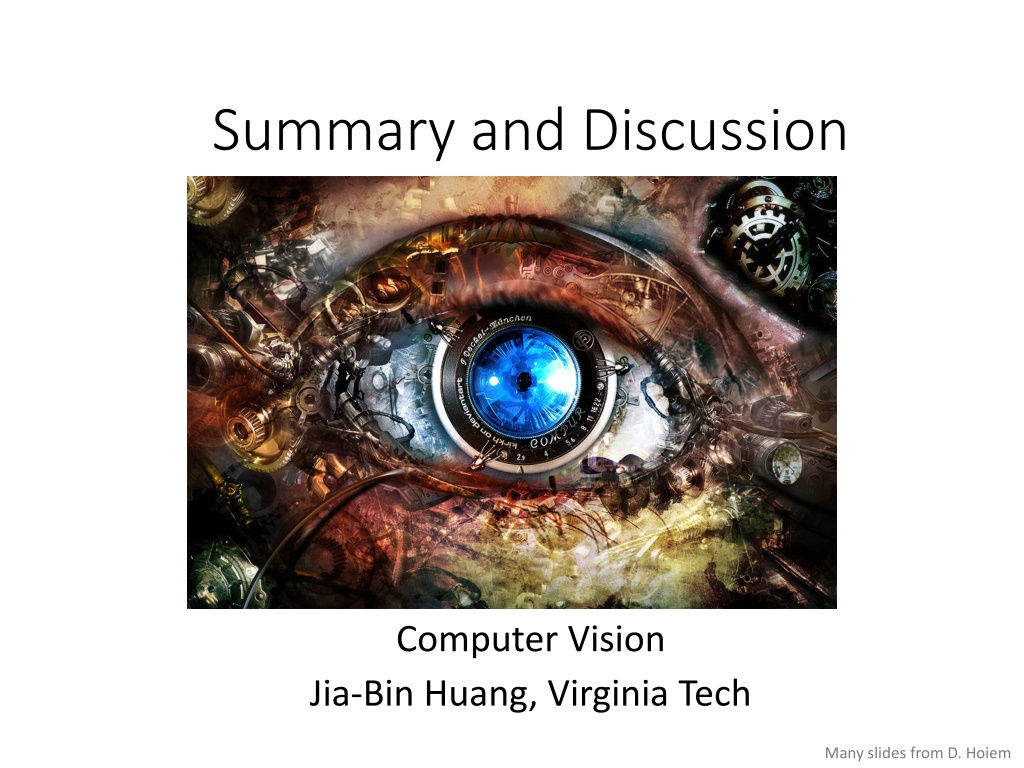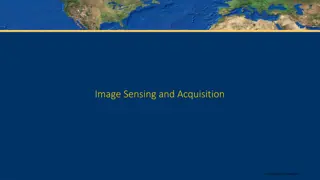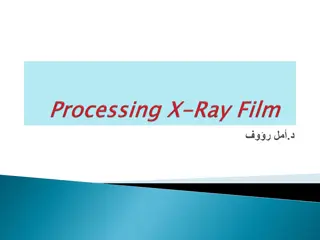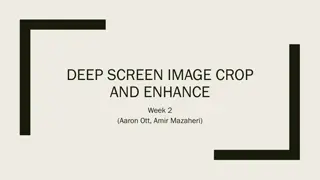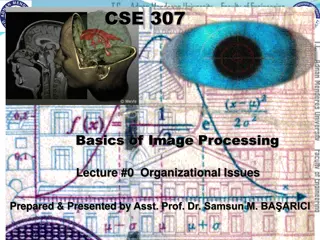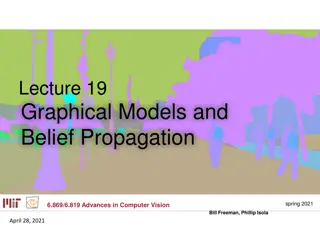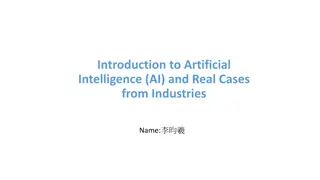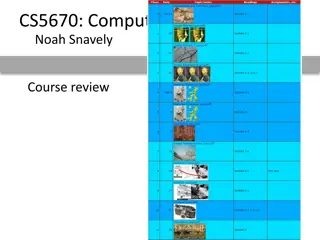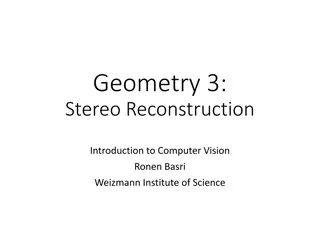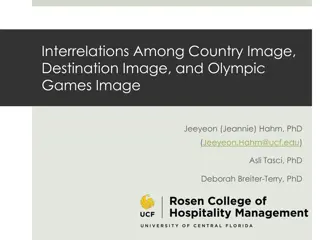Fundamentals of Computer Vision and Image Processing
Fundamentals of computer vision cover topics such as light, geometry, matching, and more. It delves into how images are recorded, how to relate world and image coordinates, measuring similarity between regions, aligning points/patches, and grouping elements together. Understanding concepts like shading, gradients, specular components, and color spaces are essential for image processing tasks. The importance of geometry in mapping 3D points to 2D points and the significance of matching in various scenarios like stereo vision, tracking, recognition, etc., are also explored. Invariant and robust representations are key for successful matching operations in computer vision.
Download Presentation

Please find below an Image/Link to download the presentation.
The content on the website is provided AS IS for your information and personal use only. It may not be sold, licensed, or shared on other websites without obtaining consent from the author. Download presentation by click this link. If you encounter any issues during the download, it is possible that the publisher has removed the file from their server.
E N D
Presentation Transcript
Summary and Discussion Computer Vision Jia-Bin Huang, Virginia Tech Many slides from D. Hoiem
Administrative stuffs Final project Poster (40%) Presentation (70%) Summary (30%) Webpage report (50%) Final exam Module 1 module 5 Simple concept questions (18 questions) One letter size cheat sheet allowed (2 side) SPOT evaluation due Dec 8th
Todays class Review of important concepts Some important open problems Feedback and course evaluation
Fundamentals of Computer Vision Light What an image records Geometry How to relate world coordinates and image coordinates Matching How to measure the similarity of two regions Alignment How to align points/patches How to recover transformation parameters based on matched points Grouping What points/regions/lines belong together? Categorization What similarities are important?
Light and Color Shading of diffuse materials depends on albedo and orientation wrt light Gradients are a major cue for changes in orientation (shape) Many materials have a specular component that directly reflects light Reflected color depends on albedo and light color RGB is default color space, but sometimes others (e.g., HSV, L*a*b) are more useful Image from Koenderink
Geometry x = K [Rt] X Maps 3d point X to 2d point x Rotation R and translation t map into 3D camera coordinates Intrinsic matrix K projects from 3D to 2D Parallel lines in 3D converge at the vanishing point in the image A 3D plane has a vanishing line in the image x T F x = 0 Points in two views that correspond to the same 3D point are related by the fundamental matrix F
Matching Does this patch match that patch? In two simultaneous views? (stereo) In two successive frames? (tracking, flow, SFM) In two pictures of the same object? (recognition) ? ?
Matching Representation: be invariant/robust to expected deformations but nothing else Assume that shape does not change Key cue: local differences in shading (e.g., gradients) Change in viewpoint Rotation invariance: rotate and/or affine warp patch according to dominant orientations Change in lighting or camera gain Average intensity invariance: oriented gradient-based matching Contrast invariance: normalize gradients by magnitude Small translations Translation robustness: histograms over small regions But can one representation do all of this? SIFT: local normalized histograms of oriented gradients provides robustness to in-plane orientation, lighting, contrast, translation HOG: like SIFT but does not rotate to dominant orientation
Alignment of points Search: efficiently align matching patches Interest points: find repeatable, distinctive points Long-range matching: e.g., wide baseline stereo, panoramas, object instance recognition Harris: points with strong gradients in orthogonal directions (e.g., corners) are precisely repeatable in x-y Difference of Gaussian: points with peak response in Laplacian image pyramid are somewhat repeatable in x-y- scale Local search Short range matching: e.g., tracking, optical flow Gradient descent on patch SSD, often with image pyramid Windowed search Long-range matching: e.g., recognition, stereo w/ scanline
Alignment of sets Find transformation to align matching sets of points Geometric transformation (e.g., affine) Least squares fit (SVD), if all matches can be trusted Hough transform: each potential match votes for a range of parameters Works well if there are very few parameters (3-4) RANSAC: repeatedly sample potential matches, compute parameters, and check for inliers Works well if fraction of inliers is high and few parameters (4-8) Other cases Thin plate spline for more general distortions One-to-one correspondence (Hungarian algorithm) A1 A3 A2
Grouping Clustering: group items (patches, pixels, lines, etc.) that have similar appearance Uses: discretize continuous values; improve efficiency; summarize data Algorithms: k-means, agglomerative Segmentation: group pixels into regions of coherent color, texture, motion, and/or label Mean-shift clustering Watershed Graph-based segmentation: e.g., MRF and graph cuts EM, mixture models: probabilistically group items that are likely to be drawn from the same distribution, while estimating the distributions parameters
Categorization Match objects, parts, or scenes that may vary in appearance Categories are typically defined by human and may be related by function, cost, or other non-visual attributes Key problem: what are important similarities? Can be learned from training examples Training Labels Training Images Image Features Classifier Training Trained Classifier
Categorization Representation: ideally should be compact, comprehensive, direct Histograms of quantized interest points (SIFT, HOG), color, texture Typical for image or region categorization Degree of spatial encoding is controllable by using spatial pyramids HOG features at specified position Often used for finding parts or objects
Object Categorization Search by Sliding Window Detector May work well for rigid objects Key idea: simple alignment for simple deformations Object or Background?
Object Categorization Search by Parts-based model Key idea: more flexible alignment for articulated objects Defined by models of part appearance, geometry or spatial layout, and search algorithm
Vision as part of an intelligent system 3D Scene Feature Extraction Optical Flow Stereo Disparity Texture Color Motion patterns Bits of objects Sense of depth Grouping Surfaces Agents and goals Shapes and properties Open paths Interpretation Objects Words Action Walk, touch, contemplate, smile, evade, read on, pick up,
Well-Established (patch matching) Major Progress (pattern matching++) New Opportunities (interpretation/tasks) Category Detection Face Detection/Recognition Entailment/Prediction Life-long Learning Human Pose Object Tracking / Flow 3D Scene Layout Multi-view Geometry Vision for Robots
Scene Understanding = Objects + People + Layout + Interpretation within Task Context
What do I see? Why is this happening? What is important? What will I see? How can we learn about the world through vision? How do we create/evaluate vision systems that adapt to useful tasks?
Important open problems How can we interpret vision given structured plans of a scene?
Important open problems Algorithms: works pretty well perfect E.g., stereo: top of wish list from Pixar guy Micheal Kass Good directions: Incorporate higher level knowledge
Important open problems Spatial understanding: what is it doing? Or how do I do it? Important questions: What are good representations of space for navigation and interaction? What kind of details are important? How can we combine single-image cues with multi-view cues?
Important open problems Object representation: what is it? Important questions: How can we pose recognition so that it lets us deal with new objects? What do we want to predict or infer, and to what extent does that rely on categorization? How do we transfer knowledge of one type of object to another?
Important open problems Can we build a core vision system that can easily be extended to perform new tasks or even learn on its own? What kind of representations might allow this? What should be built in and what should be learned?
Important open problems Vision for the masses Analyzing social effects of green space How to make vision systems that can quickly adapt to these thousands of visual tasks? Counting cells
Important problems Learning features and intermediate representations that transfer to new tasks Figure from http://www.datarobot.com/blog/a-primer-on-deep-learning/
Important open problems Almost everything is still unsolved! Robust 3D shape from multiple images Recognize objects (only faces and maybe cars is really solved, thanks to tons of data) Caption images/video Predict intention Object segmentation Count objects in an image Estimate pose Recognize actions .
If you want to learn more Read lots of papers: IJCV, PAMI, CVPR, ICCV, ECCV, NIPS Helpful topics for classes Classes in machine learning, pattern recognition, deep learning Statistics, graphical models Seminar-style paper-reading classes Just implement stuff, try demos, see what works
